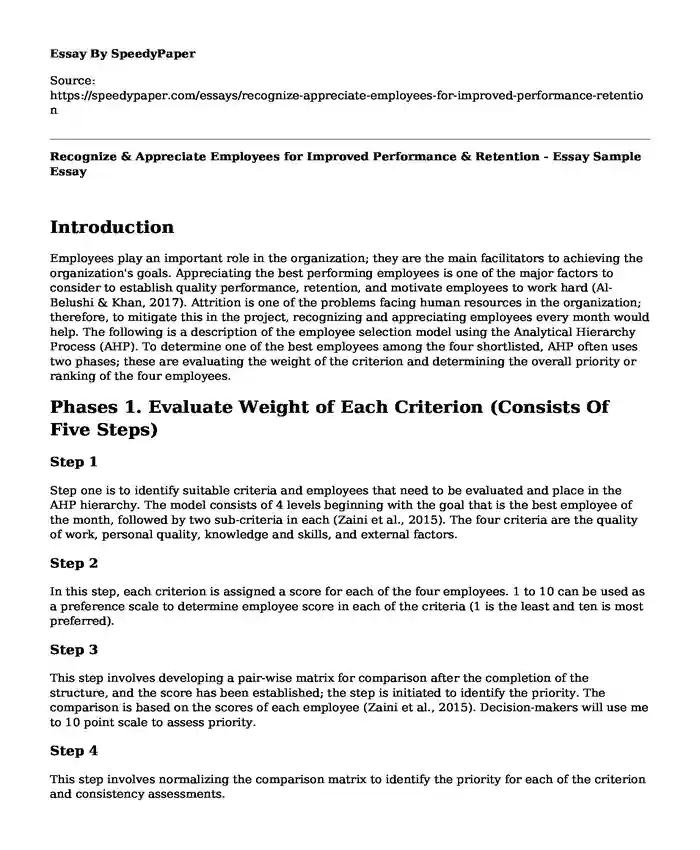
| Type of paper: | Essay |
| Categories: | Economics Analysis Employment |
| Pages: | 3 |
| Wordcount: | 805 words |
Introduction
Employees play an important role in the organization; they are the main facilitators to achieving the organization's goals. Appreciating the best performing employees is one of the major factors to consider to establish quality performance, retention, and motivate employees to work hard (Al-Belushi & Khan, 2017). Attrition is one of the problems facing human resources in the organization; therefore, to mitigate this in the project, recognizing and appreciating employees every month would help. The following is a description of the employee selection model using the Analytical Hierarchy Process (AHP). To determine one of the best employees among the four shortlisted, AHP often uses two phases; these are evaluating the weight of the criterion and determining the overall priority or ranking of the four employees.
Phases 1. Evaluate Weight of Each Criterion (Consists Of Five Steps)
Step 1
Step one is to identify suitable criteria and employees that need to be evaluated and place in the AHP hierarchy. The model consists of 4 levels beginning with the goal that is the best employee of the month, followed by two sub-criteria in each (Zaini et al., 2015). The four criteria are the quality of work, personal quality, knowledge and skills, and external factors.
Step 2
In this step, each criterion is assigned a score for each of the four employees. 1 to 10 can be used as a preference scale to determine employee score in each of the criteria (1 is the least and ten is most preferred).
Step 3
This step involves developing a pair-wise matrix for comparison after the completion of the structure, and the score has been established; the step is initiated to identify the priority. The comparison is based on the scores of each employee (Zaini et al., 2015). Decision-makers will use me to 10 point scale to assess priority.
Step 4
This step involves normalizing the comparison matrix to identify the priority for each of the criterion and consistency assessments.
Step 5
Testing the consistency is the last step in phase one; it involves measurement and validation of consistency obtained from the comparison process.
Phase Two: Ranking of Employees/ Overall Priority
After the selection and scores have been determined in the four levels, each of the four employees' performance intensity based on all sub-criterions can be measured. Summing up the global priorities for each of the employees will determine the best employee of the month.
Project Management Life Cycle Expand
Lean Six Sigma (LSS) tools and techniques can help to achieve robust improvements in the business. It is a data-driven model that uses precise techniques and tools to identify problems, solve them, and achieve the goals (Yadav & Desai, 2016). One of the most suitable tools that can assist in PMLC Failure mode effects analysis (FMEA). It is an LSS tool identified in the improvement phase. FMEA can be used to prioritize and quantify risks in PMLC and track various actions to help mitigate the risk. It has tools that are significantly useful in carrying out different improvement plans. FMEA is applicable in various levels of PMLC, for example, when identifying possible failures that might occur in a project, evaluating the results of the identified failure, and determining the severity of the impact of the failure.
FMEA uses data from previously completed processes to determine failure and its impacts on a project. It is important to determine whether the project is on the right track and assess each of the processes involved. FMEA also helps to ensure that the execution of differ t steps is successful; this takes into consideration the requirements (Albliwi et al., 2015). For example, if the project has been launched, it would be necessary to determine whether it would produce the desired outcomes. Assessing the requirements, therefore, would help to identify what may go wrong.
The information from this tool would help develop knowledge and skills in the management of projects and resources. Human resources are one of the critical components in achieving organizational goals. FMEA tool highlights various steps and requirements to help determine failure and risks, using this approach, therefore will help me gain more experience in my career and improve the capability of identifying failures and providing measures to mitigate them.
References
Al-Belushi, F., & Khan, F. R. (2017). Impact of monetary incentives on employee's motivation: Shinas college of technology, oman-a case study. International Journal of Management, Innovation & Entrepreneurial Research EISSN, 2395-7662.
Albliwi, S. A., Antony, J., & Halim Lim, S. A. (2015). A systematic review of Lean Six Sigma for the manufacturing industry. Business Process Management Journal.
Yadav, G., & Desai, T. N. (2016). Lean Six Sigma: a categorized review of the literature. International Journal of Lean Six Sigma.
Zaini, N. S., Basri, N. E., Zain, S. M., & Saad, N. F. (2015). Selecting The Best Composting Technology Using Analytical Hierarchy Process (Ahp). Jurnal Teknologi, 77(1).
Cite this page
Recognize & Appreciate Employees for Improved Performance & Retention - Essay Sample. (2023, Nov 12). Retrieved from https://speedypaper.net/essays/recognize-appreciate-employees-for-improved-performance-retention
Request Removal
If you are the original author of this essay and no longer wish to have it published on the SpeedyPaper website, please click below to request its removal:
- Ethics Essay Sample
- McDonald's: Financial Analysis Essay Example
- The US-Mexico Border and the Trump Wall, Essay Example
- Oligopoly, Mergers, and Acquisitions. Essay Example
- Essay Example: Powered Industrial Truck Standard
- Paper Example - Handling Problematic Employees at the Workplace
- Essay Sample on High-Level Recruiting Strategy
Popular categories




